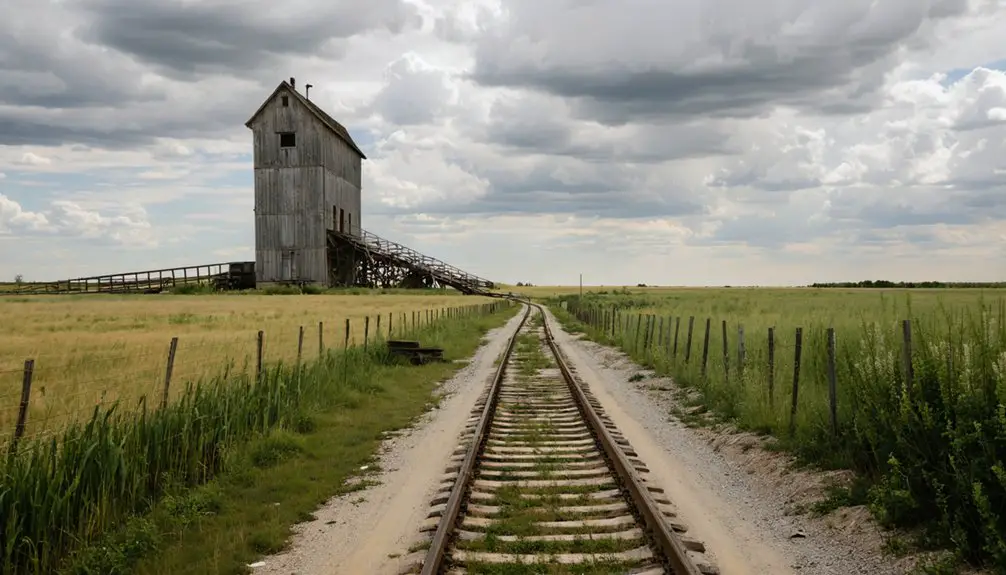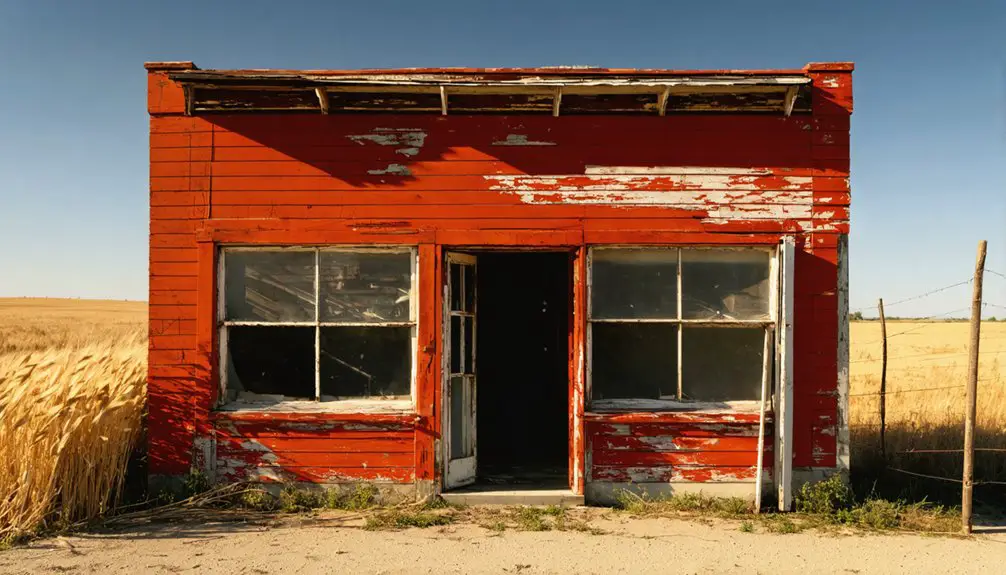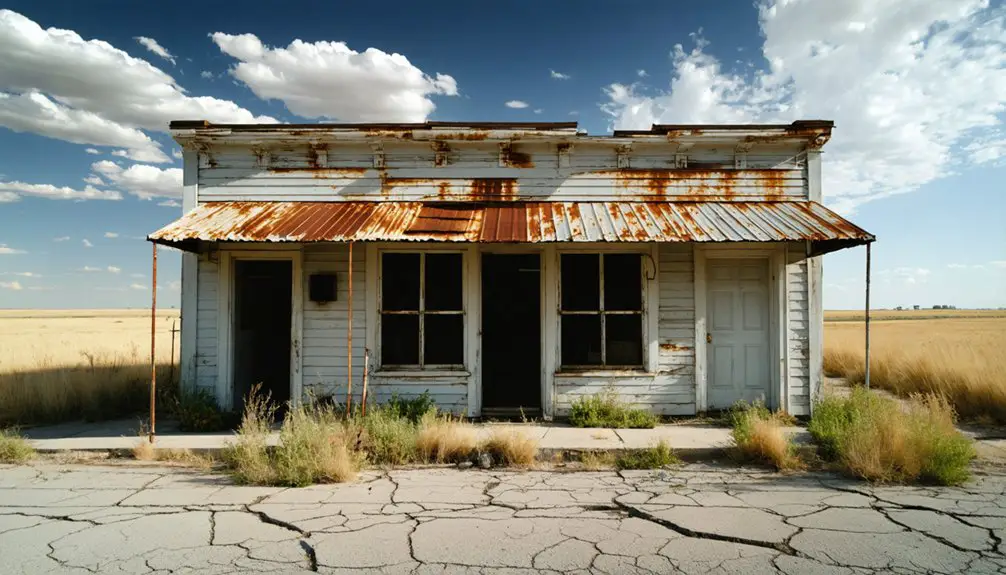You’ll find Old Kiowa’s ghost town remnants near the Kansas-Oklahoma border, where a thriving railroad community once stood. Founded in 1872, it grew rapidly with the arrival of the Southern Kansas Railway in 1886 and the Denver, Enid and Gulf Railroad in 1905. The town’s complex history includes Carrie Nation’s temperance crusades and troubling racial exclusion policies. Today, crumbling foundations and artifacts tell stories of frontier ambition, economic shifts, and environmental challenges that shaped its fate.
Key Takeaways
- Old Kiowa, established in 1872, transitioned from a thriving railroad town to a ghost town after rail service ended in 1996.
- The town’s decline accelerated during the Dust Bowl era and after a devastating flood in 1935 caused significant infrastructure damage.
- Remnants include crumbling foundations and historical artifacts, preserved by the Kiowa County Historical Museum and local preservation groups.
- The Southern Kansas Railway Company’s arrival in 1886 initially spurred growth, connecting the town to cattle trade routes.
- Population migration increased after 1960 due to mechanized farming, contributing to the town’s eventual abandonment and ghost town status.
The Birth of a Prairie Town (1872)
In 1872, a new prairie town emerged on the Kansas frontier, taking its name from the Kiowa people who’d long inhabited the Great Plains region.
You’ll find the town’s origins deeply intertwined with the complex shift of the American West, as indigenous influence gave way to settler expansion.
The strategic location near the Kansas-Oklahoma border drew pioneers who established farms and ranches on the fertile plains.
E.H. Mosley established the first trading post in spring of 1872.
As settler influx intensified, the community’s economic foundation took shape through agriculture and trade.
The Kiowa had originally migrated from their ancestral Yellowstone homeland before reaching this region.
The land, once home to the Kiowa tribe before their forced relocation under the 1867 Medicine Lodge Treaty, transformed into a bustling prairie settlement.
While early demographics weren’t well documented, you can trace the town’s establishment to broader patterns of western expansion and the dramatic reshaping of America’s frontier.
Railroad’s Golden Age and Development
The arrival of the Southern Kansas Railway Company in 1886 marked a defining chapter in Old Kiowa’s story. You’d have witnessed an ambitious railroad expansion as the company laid 200 miles of track southwest through Indian Territory to Panhandle City, Texas, opening up unprecedented economic opportunities for cattle ranching and agriculture.
Congress had paved the way two years earlier, granting railroad companies extensive rights to build through Indian Territory. While you’d have found the terrain challenging and largely unsettled, the railway’s strategic placement near White Deer Lands’ cattle pastures proved essential. The 100-foot wide right-of-way granted by Congress allowed for substantial infrastructure development along the route. The area had historical significance to Native Americans, particularly the Kom-pa-bianta people, who had traversed these lands long before the railway’s arrival.
Carrie Nation’s Anti-Saloon Legacy
Standing six feet tall and wielding her famous hatchet, Carrie Nation brought her fierce temperance crusade to Old Kiowa’s saloons during the early 1900s. After enduring her first husband’s alcoholism, she channeled her pain into a relentless campaign against liquor establishments across Kansas. During her childhood, she was raised by slaves on her father’s plantation, which shaped her deep respect for African Americans.
You can imagine her commanding presence as she stormed into local bars, smashing bottles and fixtures while singing hymns and praying. She was arrested thirty times between 1900-1910 for her destructive protests.
Nation’s temperance activism wasn’t just about destruction – she established charitable organizations and published “The Hatchet” to spread her message. Though many mocked her theatrical “hatchetations,” her efforts helped push Kansas toward stricter prohibition laws.
Beyond smashing saloons, Nation built organizations and used media to advance her anti-alcohol mission across Kansas.
Her legacy lived on through the women’s suffrage movement and eventual national Prohibition, proving that one determined woman could indeed spark significant social change.
Dark Days: The Sundown Town Era
During the darkest chapter of Kiowa’s history, racial hatred and systemic discrimination transformed this Kansas town into what became known as a “sundown town” in 1910.
You would’ve seen threatening signs posted at four major roads warning Black residents to “Read and Run,” giving them just 24 hours to flee their homes or face violent consequences.
This racial exclusion wasn’t unique to Kiowa – towns like Howard, Hays, and Liberal enforced similar practices through community intimidation, discriminatory housing policies, and outright threats.
The Jim Crow laws provided legal backing for racial segregation and sundown town practices across America during this period.
You’ll find the impact of these practices lingered long after federal civil rights legislation officially ended them in 1968.
The era’s lasting effects are still visible today in the demographic patterns and social fabric of many Kansas communities that once bore those shameful “sundown” signs.
Economic Shifts and Population Changes
As railroad expansion transformed the American frontier in the late 1800s, Kiowa emerged as an essential terminus linking southeastern Kansas to broader commercial networks.
Kiowa rose as a vital railway hub in 1800s Kansas, connecting the southeastern frontier to America’s growing commercial arteries.
You’d have seen the town flourish alongside wheat farms and cattle ranches, with the Atchison, Topeka & Santa Fe Railroad driving its growth. The area had already attracted Native American tribes who valued the Medicine River’s healing properties long before settlers arrived.
But you couldn’t escape the harsh realities that followed. Economic decline struck as railroads lost prominence, while the Dust Bowl and Great Depression forced many families to abandon their dreams. Like many ghost towns in Kansas, nearly 6,000 communities disappeared when anticipated rail lines failed to materialize.
Population migration accelerated after 1960, when mechanized farming reduced the need for workers. The devastating 1935 Kiowa Creek flood dealt another blow, destroying infrastructure that some communities never rebuilt.
While Kiowa still stands today with around 744 residents, it’s a shadow of its former prosperity.
Physical Remnants and Historical Artifacts
The scattered remnants of Old Kiowa tell a fragmented story through crumbling foundations and weathered building slabs.
You’ll find ghostly remnants of the town’s past in broken concrete sidewalks and partial masonry walls from early 20th-century public buildings. A few concrete block structures, possibly former jails, still stand as silent sentinels to the town’s history. Like many towns across Oklahoma, natural resource depletion and infrastructure changes led to abandonment.
If you’re exploring for historical artifacts, you might discover household items and agricultural tools from the settlement period, though many have been lost to time and tornadoes.
The surrounding cemeteries on low hills offer the most tangible connections to Old Kiowa’s past, with original stone markers bearing the names of early settlers.
While most of the townsite has returned to farmland, you can still trace faint outlines of old roads and building sites through distinctive vegetation patterns.
Transportation Routes and Their Impact

Railroad expansion transformed Old Kiowa’s destiny when the Denver, Enid and Gulf Railroad arrived in 1905, connecting the town to crucial trade networks throughout Kansas and Oklahoma.
You can trace the transportation evolution from indigenous travois paths to cattle trails, and finally to the iron rails that shaped the region’s future.
Before the railroad’s arrival, you’d have found yourself following the Dodge City-Tascosa Trail, part of a network of essential trade corridors that moved cattle and goods across the southern plains.
When the Atchison, Topeka and Santa Fe Railway absorbed the local line in 1907, it brought both prosperity and dependency.
The railroad’s eventual abandonment in 1996 marked a turning point, leaving Old Kiowa increasingly isolated and contributing to its decline.
Local Stories and Oral Histories
Deep within the fabric of Old Kiowa’s history lies a tapestry of oral traditions that weave together Indigenous wisdom, settler experiences, and community memories.
You’ll find stories of Kiowa spiritual practices evolving through time, from traditional Sun Dances to the integration of Christianity and peyote ceremonies. These oral traditions highlight the community’s resilience against devastating environmental challenges, including severe droughts and grasshopper invasions that tested early settlers’ determination.
Local accounts paint vivid pictures of the town’s transformation, from bustling institutions to gradual decline.
Through tipi meetings and sacred bundle ceremonies, Kiowa tribal members preserved their cultural heritage, while settler descendants passed down tales of unfulfilled railroad dreams and vanishing populations.
Together, these narratives capture the spirit of a community that faced both triumph and hardship.
Preserving Kiowa’s Historical Heritage

Since its decline from a vibrant settlement to a ghost town, preserving Old Kiowa’s historical heritage has become an essential mission for local historians and community members alike.
Through historic preservation efforts, you’ll find dedicated teams working to document and protect the remaining structures while the Kiowa County Historical Museum safeguards artifacts and stories from the past.
- You can explore detailed survey reports that identify architectural styles and construction periods unique to Old Kiowa’s buildings.
- You’ll discover how community involvement through volunteer labor and donations keeps preservation projects alive.
- You can witness how National Register listings help secure grants for restoration work.
- You’ll see how local museums preserve artifacts and oral histories that tell Old Kiowa’s story.
The combined efforts of preservation groups, museums, and community members guarantee that Old Kiowa’s legacy endures for future generations.
Frequently Asked Questions
What Were the Most Common Burial Practices in Early Kiowa Settlements?
You’d find their funeral customs centered on swift burials, destroying possessions, and avoiding grave markers. They’d paint and wash bodies, choosing remote locations to prevent spirits from haunting settlements.
How Did Local Native American Tribes Interact With Kiowa’s First Settlers?
You’ll find that Kiowa people initially maintained trade relationships with early settlers, engaging in cultural exchange through bartering and sharing hunting routes, before treaties and displacement disrupted their traditional interactions around 1865.
What Traditional Foods and Recipes Were Popular Among Kiowa’s Pioneer Families?
You’d find pioneer meals centered on wild game stews, corn fritters, potato cakes, and fermented bread. Traditional ingredients included locally-sourced vegetables, foraged plants, and preserved meats like jerky and pemmican.
Which Natural Disasters Had the Most Significant Impact on Kiowa?
You’ll find tornadoes were the deadliest threat, with devastating tornado damage reshaping your town’s history. While flood recovery challenged settlers, the 2007 Greensburg tornado reminds you of nature’s persistent destructive power.
What Types of Entertainment and Social Activities Existed in Early Kiowa?
You’d find plenty to do in early Kiowa – from saloon gatherings and community cookouts to seasonal theater shows, hunting expeditions, and social games. Recreational activities centered around outdoor pursuits and cultural entertainment.
References
- https://www2.ljworld.com/news/2015/mar/29/vanished-towns-dot-prairie-kiowa-county/
- https://www.youtube.com/watch?v=iB5rHT14eVI
- https://www.youtube.com/watch?v=VPZtNoncnig
- https://legendsofkansas.com/kansas-ghost-town-list/
- https://en.wikipedia.org/wiki/Kiowa
- https://fhsuguides.fhsu.edu/kansasheritage/barbercounty
- https://www.okhistory.org/publications/enc/entry?entry=KI017
- https://kids.kiddle.co/Kiowa
- http://www.pampamuseum.org/southern-kansas-railroad.html
- https://kiowacountyindependent.com/lifestyles/long-time-gone/3584-long-time-gone-abcs-of-railroad-towns-in-kiowa-county



